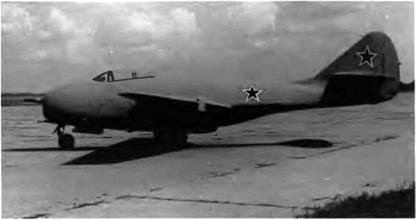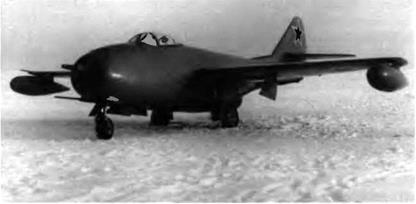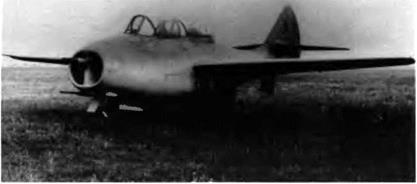1-301 / rs / MiG-9
During the summer of 1946, the Soviet command authorities decided that the first ten MiG-9 s would take part in the flyover at Red Square on 7 November The builders had no time to lose. The NKAP decree of 28 August 1946 stated: "Our aim being to produce the MiG-9 as soon as possible and to give the pilots time to train and get a feel for the machine, chief constructor A. I. Mikoyan and factory manager V. Ya. Litvinov are assigned the task of producing a small series of this aircraft (ten units).” By 22 October the ten aircraft were completed. They were practically handmade, without any production tooling. On the morning of 7 November, the flyover was canceled because of adverse weather conditions. These first ten machines can be regarded as pre – production aircraft and were in no way different from the prototypes.
The production aircraft 1-301 (factory code FS, military designation MiG-9) was different in that RD-20 engines replaced the BMW 003s. The RD-20 was a 100-percent Soviet-made version of the BMW 003. It offered the same thrust, 784 daN (800 kg st), and its mass production was organized by D. V. Kolosov in the Kazan engine factoiy The landing gear of the MiG-9 was fitted with more efficient brakes, and its fuel system was equipped with a new type of fuel cell made with a rubberized fabric developed by the VIAM (Soviet institute for aviation materials). During the test flights of the first ten MiG-9s equipped with these cells, no leaks were noted. These cells allowed the engineers to put to use all of the space available in the aircraft structure. Their capacity was of the greatest importance because the engines were so thirsty.
The armament was similar to that of the prototypes: one N-37 with forty rounds and two NS-23s with 80 rpg The first production aircraft was rolled out on 13 October 1946 and first flown by M. L. Gallai on the twenty-sixth. The first MiG-9s were railroaded to the LII airfield, where they were taken up by GK Nil WS pilots M. L. Gallai, G M. Shiyanov, L. M Kushinov, Yu. A. Antipov, A. V. Proshakov, A. V. Kotshyetkov, and D. G. Pikulenko. All these men as well as a few young air force pilots had trained hard to celebrate the October Revolution.
It was not long before the first service evaluation flights revealed the aircraft’s design flaws and shortcomings related to defective workmanship. Some of these could be corrected without difficulty, but others were more serious. For instance, when all three guns were fired simultaneously above 7,500 m (24,500 feet), the two jet engines frequently flamed out. It was later discovered that this phenomenon was a distinctive feature of all jet engines, and many years of research were needed worldwide to resolve this problem. It was part of the price an aircraft designer paid for doing without a propeller.
Test flights also demonstrated that jet aircraft needed airbrakes, and that above a speed of 500 km/h (270 kt) the pilot could not bail out. This led to the development of the first ejection seats. Other needs were brought to light as well, such as cockpit pressurization and fire protection in the engine bay. And soon it became obvious that a two – seat training aircraft with the same flight envelope as the single-seater had to be a priority.
|
The first production aircraft of the 1301 model, with its military livery. Small airbrakes (shown extended) were installed on the wmg trailing edge |
|
This production MiG-9 was experimentally fitted with two drop tanks with a capacity of 235 1 (62 US gallons) apiece. |
The first jet engines were heavier than piston engines; the advantages of not having a propeller could be appreciated only at high speeds. This explains why the takeoff roll of the MiG-9 was so long: 910 m (2,985 feet), as opposed to 234 m (768 feet) for the MiG-3. And yet the primary goal—to increase flight speed—was fully achieved thanks to the jet engine
|
The first two-seater, the FT-1. was not certified because of the poor visibility from the rear seat. |
Specifications
Span, 10 m (32 ft 9.7 in); length, 9.83 m (32 ft 3 in); height, 3.225 m (10 ft 6.7 in); wheel track, 1.95 m (6 ft 4.8 in); wheel base, 3.072 m (10 ft 0.9 in); wing area, 18.2 m2 (195.9 sq ft); empty weight, 3,420 kg (7,538 lb); takeoff weight, 4,963 kg (10,938 lb); fuel, 1,300 kg (2,865 lb); oil, 35 kg (77 lb); gas, 7 kg (15.5 lb); wing loading, 272.7 kg/m2 (55.9 lb/sq ft).
Performance
Max speed, 911 km/h at 4,500 m (492 kt at 14,760 ft); max speed at sea level, 864 km/h (467 kt); climb to 5,000 m (16,400 ft) in 4 3 min, service ceiling, 13,500 m (44,280 ft); landing speed, 170 km/h (92 kt); range, 800 km (497 mi); takeoff roll, 910 m (2,985 ft); landing roll, 735 m (2,410 ft).













